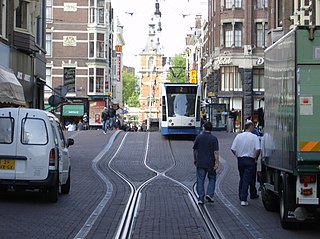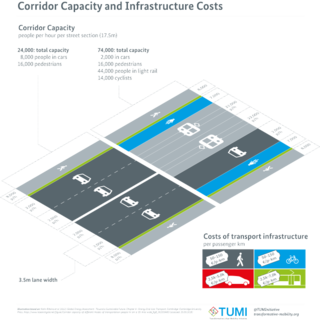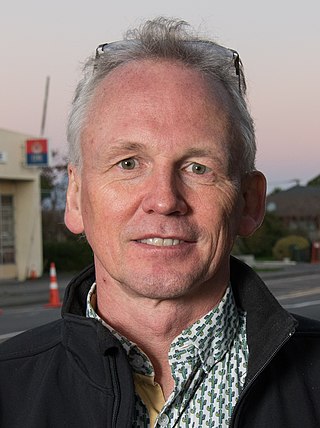
Bicycle-friendly policies and practices help some people feel more comfortable about traveling by bicycle with other traffic. The level of bicycle-friendliness of an environment can be influenced by many factors including town planning and cycling infrastructure decisions. A stigma towards people who ride bicycles and fear of cycling is a social construct that needs to be fully understood when promoting a bicycle friendly culture.

Street reclaiming is the process of converting, or otherwise returning streets to a stronger focus on non-car use — such as walking, cycling and active street life. It is advocated by many urban planners and urban economists, of widely varying political points of view. Its primary benefits are thought to be:

The Auckland Harbour Bridge is an eight-lane motorway bridge over the Waitematā Harbour in Auckland, New Zealand. It joins St Marys Bay on the Auckland city side with Northcote on the North Shore side. It is part of State Highway 1 and the Auckland Northern Motorway. The bridge is operated by the NZ Transport Agency (NZTA). It is the second-longest road bridge in New Zealand, and the longest in the North Island.

Te Araroa is New Zealand's long distance tramping route, stretching circa 3,000 kilometres (1,900 mi) along the length of the country's two main islands from Cape Reinga to Bluff. Officially opened in 2011, it is made up of a mixture of previously made tracks and walkways, new tracks, and link sections alongside roads. Tramping the full length of the trail generally takes three to six months.

Complete streets is a transportation policy and design approach that requires streets to be planned, designed, operated and maintained to enable safe, convenient and comfortable travel and access for users of all ages and abilities regardless of their mode of transportation. Complete Streets allow for safe travel by those walking, cycling, driving automobiles, riding public transportation, or delivering goods.
A travel plan is a package of actions designed by a workplace, school or other organisation to encourage safe, healthy and sustainable travel options. By reducing car travel, travel plans can improve health and wellbeing, free up car parking space, and make a positive contribution to the community and the environment. Every travel plan is different, but most successful plans have followed a structured process in their development.

In urban planning, walkability is the accessibility of amenities by foot. It is based on the idea that urban spaces should be more than just transport corridors designed for maximum vehicle throughput. Instead, it should be relatively complete livable spaces that serve a variety of uses, users, and transportation modes and reduce the need for cars for travel.

Cycling Action Network (CAN) is a national cycling advocacy group founded in November 1996 in Wellington, New Zealand. They lobby government, local authorities, businesses and the community on behalf of cyclists, for a better cycling environment. It aims to achieve a better cycling environment for cycling as transport. Major initiatives are the annual Cycle Friendly Awards and support for a biennial Cycling Conference. The organisation was originally named Cycling Advocates' Network until it was formally changed at the annual general meeting on 20 March 2016.

A pedestrian village is a compact, pedestrian-oriented neighborhood or town with a mixed-use village center. Shared-use lanes for pedestrians and those using bicycles, Segways, wheelchairs, and other small rolling conveyances that do not use internal combustion engines. Generally, these lanes are in front of the houses and businesses, and streets for motor vehicles are always at the rear. Some pedestrian villages might be nearly car-free with cars either hidden below the buildings, or on the boundary of the village. Venice, Italy is essentially a pedestrian village with canals. Other examples of a pedestrian village include Giethoorn village located in the Dutch province of Overijssel, Netherlands, Mont-Tremblant Pedestrian Village located beside Mont-Tremblant, Quebec, Canada, and Culdesac Tempe in Tempe, Arizona.

Cycling in New Zealand is the 5th most popular form of active recreation, but a very marginal commuting mode, with the share hovering around 1–3% in most major cities. This is due to a number of factors, principally safety fears.

Active mobility, soft mobility, active travel, active transport or active transportation is the transport of people or goods, through non-motorized means, based around human physical activity. The best-known forms of active mobility are walking and cycling, though other modes include running, rowing, skateboarding, kick scooters and roller skates. Due to its prevalence, cycling is sometimes considered separately from the other forms of active mobility.
The NZ Cycling Conference is a series of cycle planning conferences started in 1997 in Hamilton. Since 2001, the conference series has a biennial schedule. The conferences are one of the key ways of exchanging expertise about planning and design for cycling in New Zealand. Starting in 2012, the scope of the conference includes both walking and cycling, by combining the previous Living Streets Aotearoa biennial NZ Walking Conference series, and was rebranded "2WALKandCYCLE".

Spokes Canterbury is the main cycling advocacy group in Canterbury, New Zealand. It was established in November 1998, as a successor to the former Canterbury Cyclists' Association. Cycling Action Network is the parent organisation for Spokes Canterbury. It has about 900 members, including "everyday" cyclists, road cyclists and mountain bikers.

The New Zealand Cycle Friendly Awards were devised by the Cycling Advocates' Network (CAN) in 2003. The purpose of the awards is to acknowledge and celebrate some of the most notable achievements in the country that are helping to promote cycling and to create a cycle-friendly environment. Since 2016, the awards have been jointly organised with the New Zealand Transport Agency and rebranded as the 'Bike to the Future Awards'.

Cycling in Auckland is a mode of transport in Auckland, New Zealand. The dominance of the car in the city, the negative attitudes of car drivers and general changes in transport patterns have made it a very marginal transport mode in the early 21st century, with remaining cyclists often riding for leisure and sports purposes.

Celia Margaret Wade-Brown is a New Zealand politician who has been a Green Party list MP since 19 January 2024. She previously served as the 34th mayor of Wellington, the capital city of New Zealand, from 2010 until 2016.

The Coastal Walkway is a 12.7-kilometre (7.9 mi) long walkway located along the coast of New Plymouth, New Zealand. The walkway stretches from near Port Taranaki, past the central city, through Hickford Park, past Bell Block Beach and to Tiromoana Crescent in Bell Block, north-east of New Plymouth. The walkway runs through a number of bridges, most notably, the Te Rewa Rewa Bridge.
The International Federation of Pedestrians (IFP) is an umbrella federation for national pedestrian organisations, promoting and defending walking as a form of sustainable mobility throughout the world. IFP was founded in 1963, and received UN accreditation in 1971.

The green transport hierarchy (Canada), street user hierarchy (US), sustainable transport hierarchy (Wales), urban transport hierarchy or road user hierarchy is a hierarchy of modes of passenger transport prioritising green transport. It is a concept used in transport reform groups worldwide and in policy design. In 2020, the UK government consulted about adding to the Highway Code a road user hierarchy prioritising pedestrians. It is a key characteristic of Australian transport planning.

Axel Peter Carl Downard-Wilke is a New Zealand transport planner and engineer known for his advocacy for cyclists in cities. Born in Germany, he moved to New Zealand for his education, and from 1997 to 2005 he worked for the Christchurch City Council as a traffic engineer, where he became involved in various projects to improve the safety of cycling in the city. He then co-established a consultancy firm practising in the areas of traffic engineering, transportation planning and town planning. Downard-Wilke was a member of the technical team for the New Zealand Cycle Trail Project, and one of the lead authors of the New Zealand Cycle Trail Design Guide first published in February 2010.
















